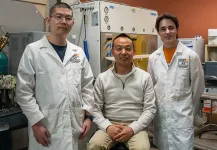(Press-News.org) When cancer patients undergo chemotherapy, the dose of most drugs is calculated based on the patient’s body surface area. This is estimated by plugging the patient’s height and weight into an equation, dating to 1916, that was formulated from data on just nine patients.
This simplistic dosing doesn’t take into account other factors and can lead to patients receiving either too much or too little of a drug. As a result, some patients likely experience avoidable toxicity or insufficient benefit from the chemotherapy they receive.
To make chemotherapy dosing more accurate, MIT engineers have come up with an alternative approach that can enable the dose to be personalized to the patient. Their system measures how much drug is in the patient’s system, and these measurements are fed into a controller that can adjust the infusion rate accordingly.
CAMBRIDGE, MA -- This approach could help to compensate for differences in drug pharmacokinetics caused by body composition, genetic makeup, chemotherapy-induced toxicity of the organs that metabolize the drugs, interactions with other medications being taken and foods consumed, and circadian fluctuations in the enzymes responsible for breaking down chemotherapy drugs, the researchers say.
“Recognizing the advances in our understanding of how drugs are metabolized, and applying engineering tools to facilitate personalized dosing, we believe, can help transform the safety and efficacy of many drugs,” says Giovanni Traverso, an associate professor of mechanical engineering at MIT, a gastroenterologist at Brigham and Women’s Hospital, and the senior author of the study.
Louis DeRidder, an MIT graduate student, is the lead author of the paper, which appears today in the journal Med.
Continuous monitoring
In this study, the researchers focused on a drug called 5-fluorouracil, which is used to treat colorectal cancers, among others. The drug is typically infused over a 46-hour period, and the dosage is determined using a formula based on the patient’s height and weight, which gives the estimated body surface area.
However, that approach doesn’t account for differences in body composition that can affect how the drug spreads through the body, or genetic variations that influence how it is metabolized. Those differences can lead to harmful side effects, if too much drug is present. If not enough drug is circulating, it may not kill the tumor as expected.
“People with the same body surface area could have very different heights and weights, could have very different muscle masses or genetics, but as long as the height and the weight plugged into this equation give the same body surface area, their dose is identical,” says DeRidder, a PhD candidate in the Medical Engineering and Medical Physics program within the Harvard-MIT Program in Health Sciences and Technology.
Another factor that can alter the amount of drug in the bloodstream at any given time is circadian fluctuations of an enzyme called dihydropyrimidine dehydrogenase (DPD), which breaks down 5-fluorouracil. DPD’s expression, like many other enzymes in the body, is regulated on a circadian rhythm. Thus, the degradation of 5-FU by DPD is not constant but changes according to the time of the day. These circadian rhythms can lead to tenfold fluctuations in the amount of 5-fluorouracil in a patient’s bloodstream over the course of an infusion.
“Using body surface area to calculate a chemotherapy dose, we know that two people can have profoundly different toxicity from 5-fluorouracil chemotherapy. Looking at one patient, they can have cycles of treatment with minimal toxicity and then have a cycle with miserable toxicity. Something changed in how that patient metabolized chemo from one cycle to the next. Our antiquated dosing fails to capture that change, and patients suffer as a result,” says Douglas Rubinson, a clinical oncologist at Dana-Farber Cancer Institute and an author of the paper.
One way to try to counteract the variability in chemotherapy pharmacokinetics is a strategy called therapeutic drug monitoring, in which the patient gives a blood sample at the end of one treatment cycle. After this sample is analyzed for the drug concentration, the dosage can be adjusted, if needed, at the beginning of the next cycle (usually two weeks later for 5-fluorouracil). This approach has been shown to result in better outcomes for patients, but it is not widely used for chemotherapies such as 5-fluorouracil.
The MIT researchers wanted to develop a similar type of monitoring, but in a manner that is automated and enables real-time drug personalization, which could result in better outcomes for patients. In their “closed-loop” system, drug concentrations can be continually monitored, and that information is used to automatically adjust the infusion rate of the chemotherapy drug and keep the dose within the target range. Such a closed-loop system enables personalization of the drug dose in a manner that considers circadian rhythm changes in the levels of drug-metabolizing enzymes, as well as any changes in the patient’s pharmacokinetics since their last treatment, such as chemotherapy-induced toxicity of the organs that metabolize the drugs.
The new system they designed, known as CLAUDIA (Closed-Loop AUtomated Drug Infusion regulAtor), makes use of commercially available equipment for each step. Blood samples are taken every five minutes and rapidly prepared for analysis. The concentration of 5-fluorouracil in the blood is measured and compared to the target range. The difference between the target and measured concentration is input to a control algorithm, which then adjusts the infusion rate if necessary, to keep the dose within the range of concentrations between which the drug is effective and nontoxic.
“What we’ve developed is a system where you can constantly measure the concentration of drug and adjust the infusion rate accordingly, to keep the drug concentration within the therapeutic window,” DeRidder says.
Rapid adjustment
In tests in animals, the researchers found that using CLAUDIA, they could keep the amount of drug circulating in the body within the target range around 45 percent of the time. Drug levels in animals that received chemotherapy without CLAUDIA remained in the target range only 13 percent of the time, on average. In this study, the researchers did not do any tests of the effectiveness of the drug levels, but keeping the concentration within the target window is believed to lead to better outcomes and less toxicity.
CLAUDIA was also able to keep the dose of 5-fluorouracil within the target range even when the researchers administered a drug that inhibits the DPD enzyme. In animals that received this inhibitor without continuous monitoring and adjustment, levels of 5-fluorouracil increased by up to eightfold.
For this demonstration, the researchers manually performed each step of the process, using off-the-shelf equipment, but they now plan to work on automating each step so that the monitoring and dose adjustment can be done without any human intervention.
To measure drug concentrations, the researchers used high-performance liquid chromatography mass spectroscopy (HPLC-MS), a technique that could be adapted to detect nearly any type of drug.
“We foresee a future where we’re able to use CLAUDIA for any drug that has the right pharmacokinetic properties and is detectable with HPLC-MS, thereby enabling the personalization of dosing for many different drugs,” DeRidder says.
The research was funded by the National Science Foundation Graduate Research Fellowship Program, a MathWorks Fellowship, MIT’s Karl van Tassel Career Development Professorship, the MIT Department of Mechanical Engineering, and the Bridge Project, a partnership between the Koch Institute for Integrative Cancer Research at MIT and the Dana-Farber/Harvard Cancer Center.
###
Other authors of the paper include Kyle A. Hare, Aaron Lopes, Josh Jenkins, Nina Fitzgerald, Emmeline MacPherson, Niora Fabian, Josh Morimoto, Jacqueline N. Chu, Ameya R. Kirtane, Wiam Madani, Keiko Ishida, Johannes L. P. Kuosmanen, Naomi Zecharias, Christopher M. Colangelo, Hen-Wei Huang, Makaya Chilekwa, Nikhil B. Lal, Shriya S. Srinivasan, Alison M Hayward, Brian M. Wolpin, David Trumper, Troy Quast, and Robert Langer.
END
A closed-loop drug-delivery system could improve chemotherapy
New CLAUDIA system could continuously monitor patients during an infusion and adjust dosage to maintain optimal drug levels.
2024-04-24
ELSE PRESS RELEASES FROM THIS DATE:
MIT scientists tune the entanglement structure in an array of qubits
2024-04-24
Entanglement is a form of correlation between quantum objects, such as particles at the atomic scale. This uniquely quantum phenomenon cannot be explained by the laws of classical physics, yet it is one of the properties that explains the macroscopic behavior of quantum systems.
Because entanglement is central to the way quantum systems work, understanding it better could give scientists a deeper sense of how information is stored and processed efficiently in such systems.
Qubits, or quantum bits, are the building blocks of a quantum computer. However, it is extremely difficult to make specific entangled states in many-qubit ...
Geologists discover rocks with the oldest evidence yet of Earth’s magnetic field
2024-04-24
Geologists at MIT and Oxford University have uncovered ancient rocks in Greenland that bear the oldest remnants of Earth’s early magnetic field.
The rocks appear to be exceptionally pristine, having preserved their properties for billions of years. The researchers determined that the rocks are about 3.7 billion years old and retain signatures of a magnetic field with a strength of at least 15 microtesla. The ancient field is similar in magnitude to the Earth’s magnetic field today.
The open-access findings, appearing ...
It’s easier now to treat opioid addiction with medication -- but use has changed little
2024-04-24
For years, even as opioid overdose deaths dramatically increased, doctors and other prescribers in the United States needed special permission from the federal government if they wanted to prescribe buprenorphine, a medication that helps patients overcome opioid addiction and prevents fatal overdoses.
That requirement, called an “X waiver”, was eliminated on January 12, 2023 due to an item in a major federal budget bill. This meant that suddenly, any clinician who had a license to prescribe controlled substances could prescribe ...
Researchers publish final results of key clinical trial for gene therapy for sickle cell disease
2024-04-24
Philadelphia, April 24, 2024 – In a landmark study, an international consortium led by researchers at Children’s Hospital of Philadelphia (CHOP) published the final results of a key clinical trial of the gene therapy CASGEVY (exagamglogene autotemcel) for the treatment of sickle cell disease in patients 12 years and older with recurrent vaso-occlusive crises (VOCs). The study found that 96.7% of patients in the study did not have any vaso-occlusive crises (VOCs) – a blockage that results in lack of oxygen and painful episodes – for at least one year, and 100% were able to remain hospitalization-free for the same ...
Identifying proteins causally related to COVID-19, healthspan and lifespan
2024-04-24
“[...] we identified multiple proteins affecting COVID-19 and aging.”
BUFFALO, NY- April 24, 2024 – A new research paper was published in Aging (listed by MEDLINE/PubMed as "Aging (Albany NY)" and "Aging-US" by Web of Science) Volume 16, Issue 7, entitled, “Using genetics and proteomics data to identify proteins causally related to COVID-19, healthspan and lifespan: a Mendelian randomization study.”
The COVID-19 pandemic poses a heavy burden on public health and accounts for substantial mortality and morbidity. Proteins are building blocks of life, but specific proteins causally related ...
New study reveals how AI can enhance flexibility, efficiency for customer service centers
2024-04-24
BINGHAMTON, N.Y. -- Whenever you call a customer service contact center, the team on the other end of the line typically has three goals: to reduce their response time, solve your problem and do it within the shortest service time possible.
However, resolving your problem might entail a significant time investment, potentially clashing with an overarching business objective to keep service duration to a minimum. These conflicting priorities can be commonplace for customer service contact centers, which often rely on the latest technology to meet customers’ ...
UT School of Natural Resources team receives grant to remove ‘forever chemicals’ from water
2024-04-24
Mi Li, assistant professor in the University of Tennessee Center for Renewable Carbon and the UT School of Natural Resources, received a $75,000 research grant from the U.S. Environmental Protection Agency (EPA) for a two-year project using a cellulose-functionalized adsorbent to remove per- and polyfluoroalkyl substances (PFAS) from water. Li has built a student team to work on this project including Kailong Zhang, a Ph.D. student in the School of Natural Resources, and Ryan Baskette, an undergraduate student in the Department of Biochemistry and Cellular and Molecular Biology.
The grant comes from the EPA’s People, Prosperity, and the Planet Program, which provided almost ...
Sweet potato quality analysis is enhanced with hyperspectral imaging and AI
2024-04-24
URBANA, Ill. – Sweet potatoes are a popular food choice for consumers worldwide because of their delicious taste and nutritious quality. The red, tuberous root vegetable can be processed into chips and fries, and it has a range of industrial applications, including textiles, biodegradable polymers, and biofuels.
Sweet potato quality assessment is crucial for producers and processors because features influence texture and taste, consumer preferences, and viability for different purposes. A new study from the University of Illinois Urbana-Champaign explores the use of hyperspectral imaging and explainable artificial intelligence (AI) to assess ...
Use of acid reflux drugs linked to higher risk of migraine
2024-04-24
EMBARGOED FOR RELEASE UNTIL 4 P.M. ET, WEDNESDAY, APRIL 24, 2024
MINNEAPOLIS – People who take acid-reducing drugs may have a higher risk of migraine and other severe headache than people who do not take these medications, according to a study published in the April 24, 2024, online issue of Neurology® Clinical Practice, an official journal of the American Academy of Neurology. The acid-reducing drugs include proton pump inhibitors such as omeprazole and esomeprazole, histamine H2-receptor antagonists, or H2 blockers, such as cimetidine and famotidine, and antacid supplements.
The study does not prove that acid-reducing drugs cause migraine; ...
For immigrants to Canada, risk of MS increases with proportion of life spent there
2024-04-24
EMBARGOED FOR RELEASE UNTIL 4 P.M. ET, WEDNESDAY, APRIL 24, 2024
MINNEAPOLIS – Immigrants to Canada who have spent a greater proportion of their lives in Canada have a greater risk of developing multiple sclerosis (MS) than people who have spent a smaller proportion of their lives there, according to a study published in the April 24, 2024, online issue of Neurology®, the medical journal of the American Academy of Neurology. The study does not prove that an increased proportion of life in Canada causes MS; ...
LAST 30 PRESS RELEASES:
New mega-analysis reveals why memory declines with age
Understanding ammonia energy’s tradeoffs around the world
UTHealth Houston researchers map gene disruptions in sporadic early onset Alzheimer’s disease across key brain regions
Minimum wage increases are linked to safer pregnancies
Left in the cold: Study finds most renters shut out of energy-saving upgrades
This crystal sings back: Illinois collaboration sheds light on magnetochiral instability
Organisms in the Atacama Desert soil are remarkably diverse
Children’s Hospital Colorado research outlines first pediatric classifications for suicide risk in adolescents and kids
No thyme wasted: Harnessing the medicinal benefits of thyme extract With small doses
Fat surrounding the colon interacts with the immune system
Genetic predisposition to excess body weight and survival in women diagnosed with breast cancer
New mechanism links Epstein-Barr virus to MS
Genetic risk factor and viral infection jointly contribute to MS
When a virus releases the immune brake: New evidence on the onset of multiple sclerosis
Wyss Institute-led collaboration awarded by ARPA-H PRINT program to engineer off-the-shelf, universal, transplant-ready graft for liver failure
Research on the behavioral mechanisms of rural distributed photovoltaic development: A view of prosumer perspective
More surgical patients are on opioid use disorder medications — hospitals must modernize pain care
New study reveals strategic logic behind global patent litigation venue selection
An abnormally slow heart rate is associated with xylazine-fentanyl overdose; primarily seen in northeastern United States
The path to solar weather forecasts
Inflammation and mitochondrial dysfunction in cirrhotic cardiomyopathy: therapeutic implications
The Great Bear Rainforest nature writing retreat
Research reveals hidden diversity of E. coli driving diabetic foot infections
Breakthrough in parallel Cartesian grid generation: Dynamic partition weight strategy resolves load imbalance
ESMT Berlin study shows how startups can communicate to win over silent audiences online
Design and optimization of wide-speed double swept waverider based on curved-cone projection method
Giant Magellan Telescope names Daniel T. Jaffe as president
New parameterization method for cislunar space cataloging enhances orbital awareness in Earth-Moon system
A “nu” way to measure researcher impact
Dark matter may have begun much hotter than scientists thought
[Press-News.org] A closed-loop drug-delivery system could improve chemotherapyNew CLAUDIA system could continuously monitor patients during an infusion and adjust dosage to maintain optimal drug levels.




